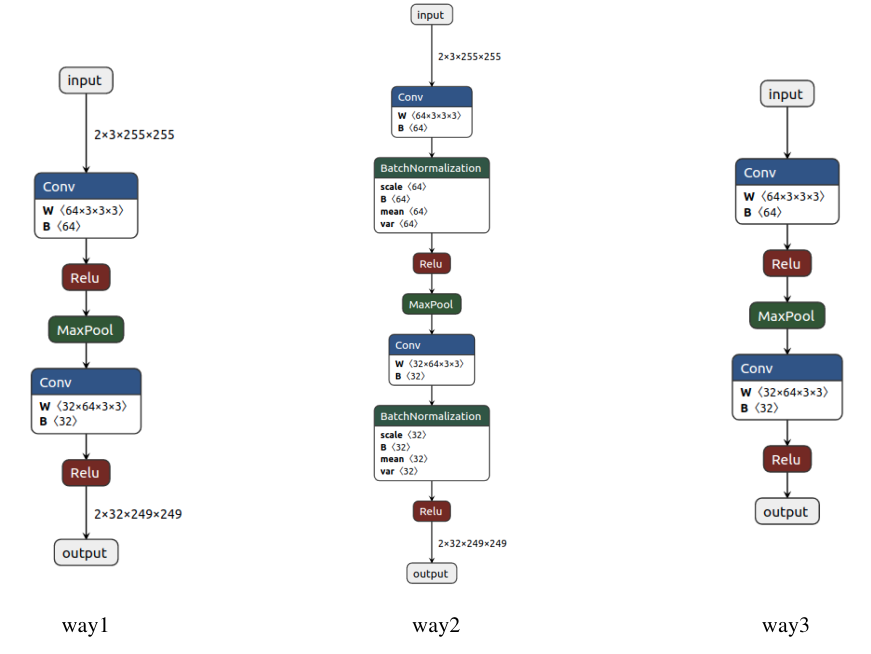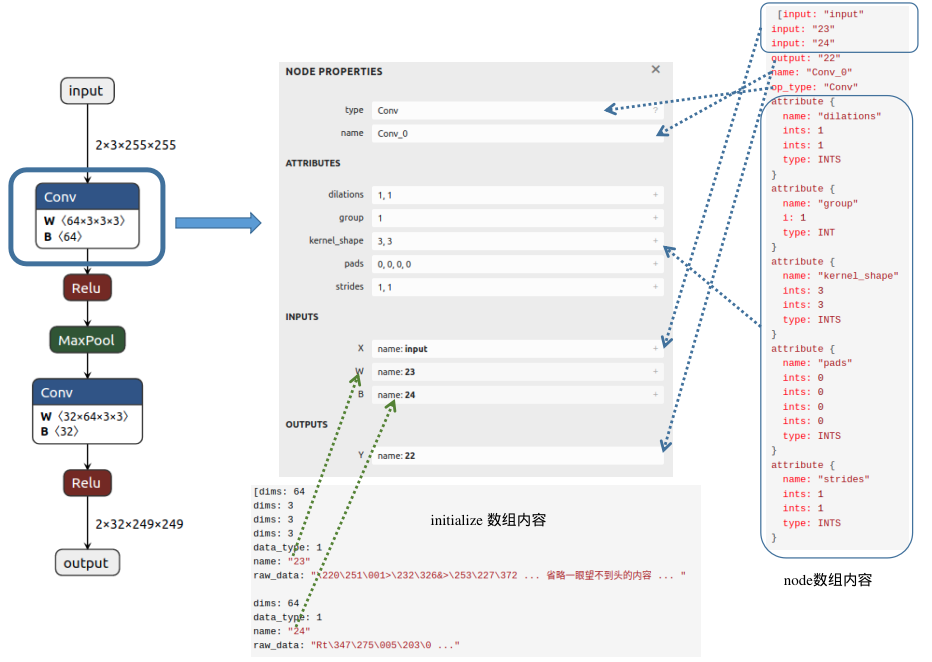【推理引擎】ONNX 模型解析
定义模型结构
首先使用 PyTorch 定义一个简单的网络模型:
class ConvBnReluBlock(nn.Module):
def __init__(self) -> None:
super().__init__()
self.conv1 = nn.Conv2d(3, 64, 3)
self.bn1 = nn.BatchNorm2d(64)
self.maxpool1 = nn.MaxPool2d(3, 1)
self.conv2 = nn.Conv2d(64, 32, 3)
self.bn2 = nn.BatchNorm2d(32)
self.relu = nn.ReLU()
def forward(self, x):
out = self.conv1(x)
out = self.bn1(out)
out = self.relu(out)
out = self.maxpool1(out)
out = self.conv2(out)
out = self.bn2(out)
out = self.relu(out)
return out
在导出模型之前,需要提前定义一些变量:
model = ConvBnReluBlock() # 定义模型对象
x = torch.randn(2, 3, 255, 255) # 定义输入张量
然后使用 PyTorch 官方 API(torch.onnx.export)导出 ONNX 格式的模型:
# way1:
torch.onnx.export(model, (x), "conv_bn_relu_evalmode.onnx", input_names=["input"], output_names=['output'])
# way2:
import torch._C as _C
TrainingMode = _C._onnx.TrainingMode
torch.onnx.export(model, (x), "conv_bn_relu_trainmode.onnx", input_names=["input"], output_names=['output'],
opset_version=12, # 默认版本为9,但是如果低于12,将不能正确导出 Dropout 和 BatchNorm 节点
training=TrainingMode.TRAINING, # 默认模式为 TrainingMode.EVAL
do_constant_folding=False) # 常量折叠,默认为True,但是如果使用TrainingMode.TRAINING模式,则需要将其关闭
# way3
torch.onnx.export(model,
(x),
"conv_bn_relu_dynamic.onnx",
input_names=['input'],
output_names=['output'],
dynamic_axes={'input': {0: 'batch_size', 2: 'input_width', 3: 'input_height'},
'output': {0: 'batch_size', 2: 'output_width', 3: 'output_height'}})
可以看到,这里主要以三种方式导出模型,下面分别介绍区别:
- way1:如果模型中存在 BatchNorm 或者 Dropout,我们在导出模型前会首先将其设置成 eval 模式,但是这里我们即使忘记设置也无所谓,因为在导出模型时会自动设置(export函数中training参数的默认值为TrainingMode.EVAL)。
- way2:如果我们想导出完整的模型结构,包括 BatchNorm 和 Dropout,则应该将 training 属性设置为 train 模式。
- way3:如果想要导出动态输入的模型结构,则需要设置 dynamic_axes 属性,比如这里我们将第一、三和四维设置成动态结构,那么我们就可以输入任何Batch大小、任何长宽尺度的RGB图像。
下图分别将这三种导出方式的模型结构使用 Netron 可视化:

分析模型结构
这里参考了BBuf大佬的讲解:【传送门:https://zhuanlan.zhihu.com/p/346511883】
接下来主要针对 way1 方式导出的ONNX模型进行深入分析。
ONNX格式定义:https://github.com/onnx/onnx/blob/master/onnx/onnx.proto
在这个文件中,定义了多个核心对象:ModelProto、GraphProto、NodeProto、ValueInfoProto、TensorProto 和 AttributeProto。
在加载ONNX模型之后,就获得了一个ModelProto,其中包含一些
- 版本信息(本例中:ir_version = 7)
- 生成者信息:producer_name: pytorch,producer_version: 1.10,这两个属性主要用来说明由哪些框架哪个版本导出的onnx
- 核心组件:GraphProto
在 GraphProto 中,有如下几个属性需要注意:
- name:本例中:name = 'torch-jit-export'
- input 数组:
[name: "input"
type {
tensor_type {
elem_type: 1
shape {
dim {
dim_value: 2
}
dim {
dim_value: 3
}
dim {
dim_value: 255
}
dim {
dim_value: 255
}
}
}
}
]
- output 数组:
[name: "output"
type {
tensor_type {
elem_type: 1
shape {
dim {
dim_value: 2
}
dim {
dim_value: 32
}
dim {
dim_value: 249
}
dim {
dim_value: 249
}
}
}
}
]
- node 数组,该数组中包含了模型中所有的计算节点(本例中:"Conv_0"、"Relu_1"、"MaxPool_2"、"Conv_3"、"Relu_4"),以及各个节点的属性,:
[input: "input"
input: "23"
input: "24"
output: "22"
name: "Conv_0"
op_type: "Conv"
attribute {
name: "dilations"
ints: 1
ints: 1
type: INTS
}
attribute {
name: "group"
i: 1
type: INT
}
attribute {
name: "kernel_shape"
ints: 3
ints: 3
type: INTS
}
attribute {
name: "pads"
ints: 0
ints: 0
ints: 0
ints: 0
type: INTS
}
attribute {
name: "strides"
ints: 1
ints: 1
type: INTS
}
,
input: "22"
output: "17"
name: "Relu_1"
op_type: "Relu"
, input: "17"
output: "18"
name: "MaxPool_2"
op_type: "MaxPool"
attribute {
name: "kernel_shape"
ints: 3
ints: 3
type: INTS
}
attribute {
name: "pads"
ints: 0
ints: 0
ints: 0
ints: 0
type: INTS
}
attribute {
name: "strides"
ints: 1
ints: 1
type: INTS
}
,
input: "18"
input: "26"
input: "27"
output: "25"
name: "Conv_3"
op_type: "Conv"
attribute {
name: "dilations"
ints: 1
ints: 1
type: INTS
}
attribute {
name: "group"
i: 1
type: INT
}
attribute {
name: "kernel_shape"
ints: 3
ints: 3
type: INTS
}
attribute {
name: "pads"
ints: 0
ints: 0
ints: 0
ints: 0
type: INTS
}
attribute {
name: "strides"
ints: 1
ints: 1
type: INTS
}
,
input: "25"
output: "output"
name: "Relu_4"
op_type: "Relu"
]
通过以上 node 的输入输出信息,可提取出节点之间的拓扑关系,构建出一个完整的神经网络。
- initializer 数组:存放模型的权重参数。
[dims: 64
dims: 3
dims: 3
dims: 3
data_type: 1
name: "23"
raw_data: "\220\251\001>\232\326&>\253\227\372 ... 省略一眼望不到头的内容 ... " dims: 64
data_type: 1
name: "24"
raw_data: "Rt\347\275\005\203\0 ..." dims: 32
dims: 64
dims: 3
dims: 3
data_type: 1
name: "26"
raw_data: "9\022\273;+^\004\2 ..." ...
至此,我们已经分析完 GraphProto 的内容,下面根据图中的一个节点可视化说明以上内容:

从图中可以发现,Conv 节点的输入包含三个部分:输入的图像(input)、权重(这里以数字23代表该节点权重W的名字)以及偏置(这里以数字24表示该节点偏置B的名字);输出内容的名字为22;属性信息包括dilations、group、kernel_shape、pads和strides,不同节点会具有不同的属性信息。在initializer数组中,我们可以找到该Conv节点权重(name:23)对应的值(raw_data),并且可以清楚地看到维度信息(64X3X3X3)。
【推理引擎】ONNX 模型解析的更多相关文章
- 阿里开源!轻量级深度学习端侧推理引擎 MNN
阿里妹导读:近日,阿里正式开源轻量级深度学习端侧推理引擎“MNN”. AI科学家贾扬清如此评价道:“与 Tensorflow.Caffe2 等同时覆盖训练和推理的通用框架相比,MNN 更注重在推理时的 ...
- 阿里开源首个移动AI项目,淘宝同款推理引擎
淘宝上用的移动AI技术,你也可以用在自己的产品中了. 刚刚,阿里巴巴宣布,开源自家轻量级的深度神经网络推理引擎MNN(Mobile Neural Network),用于在智能手机.IoT设备等端侧加载 ...
- 滴滴推理引擎IFX:千万规模设备下AI部署实践
桔妹导读:「滴滴技术」将于本月开始,联合各技术团队为大家带来精彩分享.你想了解的技术干货,深度专访,团队及招聘将于每周三与你准时见面.本月为「滴滴云平台事业群分享月」,在今天的内容中,云平台事业群-机 ...
- 【推理引擎】从源码看ONNXRuntime的执行流程
目录 前言 准备工作 构造 InferenceSession 对象 & 初始化 让模型 Run 总结 前言 在上一篇博客中:[推理引擎]ONNXRuntime 的架构设计,主要从文档上对ONN ...
- 全场景AI推理引擎MindSpore Lite, 助力HMS Core视频编辑服务打造更智能的剪辑体验
移动互联网的发展给人们的社交和娱乐方式带来了很大的改变,以vlog.短视频等为代表的新兴文化样态正受到越来越多人的青睐.同时,随着AI智能.美颜修图等功能在图像视频编辑App中的应用,促使视频编辑效率 ...
- Caffe学习笔记(一):Caffe架构及其模型解析
Caffe学习笔记(一):Caffe架构及其模型解析 写在前面:关于caffe平台如何快速搭建以及如何在caffe上进行训练与预测,请参见前面的文章<caffe平台快速搭建:caffe+wind ...
- 人体姿态和形状估计的视频推理:CVPR2020论文解析
人体姿态和形状估计的视频推理:CVPR2020论文解析 VIBE: Video Inference for Human Body Pose and Shape Estimation 论文链接:http ...
- 【模型推理】Tengine 模型转换及量化
欢迎关注我的公众号 [极智视界],回复001获取Google编程规范 O_o >_< o_O O_o ~_~ o_O 本文介绍一下 Tengine 模型转换 ...
- 【推理引擎】ONNXRuntime 的架构设计
ONNXRuntime,深度学习领域的神经网络模型推理框架,从名字中可以看出它和 ONNX 的关系:以 ONNX 模型作为中间表达(IR)的运行时(Runtime). 本文许多内容翻译于官方文档:ht ...
随机推荐
- Solution -「多校联训」轮回
\(\mathcal{Description}\) 有 \(n\) 个黑盒,第 \(i\) 个黑盒可以让输入变量以 \(p_i\) 的概率保持不变,以 \(\frac{1-p_i}2\) 的概率加 ...
- Solution -「CF 555E」Case of Computer Network
\(\mathcal{Description}\) Link. 给定 \(n\) 个点 \(m\) 条边的无向图,判断是否有给每条边定向的方案,使得 \(q\) 组有序点对 \((s,t)\) ...
- win10+redhat8双系统安装(非虚拟机)
win10+redhat8双系统安装(非虚拟机) 记录这次在原有的win10系统基础上,安装了redhat 8操作系统,过程中也出现了一些状况,百度了许久,许多文章并没有效果,摸爬滚打,有了这一次的记 ...
- Linux CentOS 搭建SVN并用钩子自动实现同步到Web目录
linux安装配置SVN并设置钩子 安装说明 系统环境:CentOS-6.3安装方式:yum install (源码安装容易产生版本兼容的问题)安装软件:系统自动下载SVN软件 检查已安装版本 # ...
- React 也就这样 01——React 元素的创建和渲染
React 是一个用于构建用户界面的 JavaScript 库 它包括两个库:react.js 和 react-dom.js react.js:React 的核心库,提供了 React.js 的核心功 ...
- [GAME] [Civilization] 文明6字体及字体大小修改
一.前言 文明作为一款文本信息量较大的游戏,提供的字体和UI界面设置还是偏少了一些,对干眼用户极不友好 二.用户界面整体缩放 首先是游戏自带的缩放选项:图象选项-图像-UI质量提升,设置为150%或更 ...
- 【信而泰】网络损伤仿真,为5G应用保驾护航
5G,绝对是今年最热门的话题!2019年6月6日,工信部正式向中国电信.中国移动.中国联通.中国广电发放5G商用牌照,中国正式进入5G商用元年.5G不仅仅是一次通信技术的升级,更是开启了一个新的时代. ...
- 4款BI工具功能大对比,这款BI工具你不能错过!
在这个信息爆炸式增长的时代,挖掘数据的潜在价值显得尤为重要.越来越多的人将目光聚集于商业智能领域--BI(Business Intelligence),通过数据分析软件对来自不同的数据源进行统一的处理 ...
- 【C# Parallel】ParallelLoopState
总结 总之,要编写一个健壮的并行循环,必须在并行循环体中检测 ParallelLoopState 对象的 IsExceptional, IsStopped 和 LowestBreakIteration ...
- 【C# Task】 ValueTask/Task<TResult>
概要 1.如果异步方法的使用者使用 Task.WhenAll 或 Task.WhenAny,则在异步方法中使用 ValueTask<T> 作为返回类型可能会产生高昂的成本.这是因为您需要使 ...
